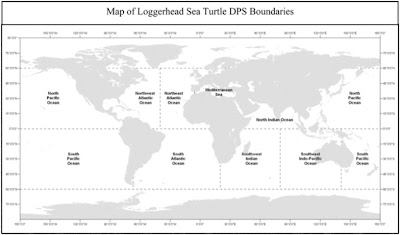Last month the National Marine Fisheries Service (NMFS) and the U.S. Fish and Wildlife Service announced the listing of nine distinct loggerhead turtle (Caretta caretta) populations under the Endangered Species Act. Since 1978, the worldwide loggerhead population has been considered as one species and listed as threatened. September’s announcement means that each population will be listed separately and bears a different listing status. Four populations will remain listed as threatened (Northwest Atlantic Ocean, South Atlantic Ocean, Southeast Indo-Pacific Ocean, and Southwest Indian Ocean), while five populations (Mediterranean Sea, North Indian Ocean, North Pacific Ocean, and South Pacific Ocean) are now listed as endangered. Southwest Florida’s loggerhead turtles fall into the Northwest Atlantic population and will maintain their threatened.status.
For more information on loggerhead turtles and the change to their status, visit NMFS's Office of Protected Resources.
 |
| Source: http://www.nmfs.noaa.gov/pr/pdfs/fr/fr76-58868.pdf |








